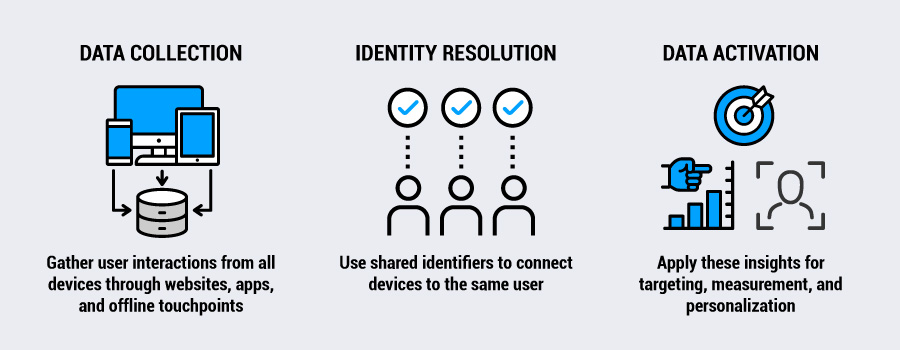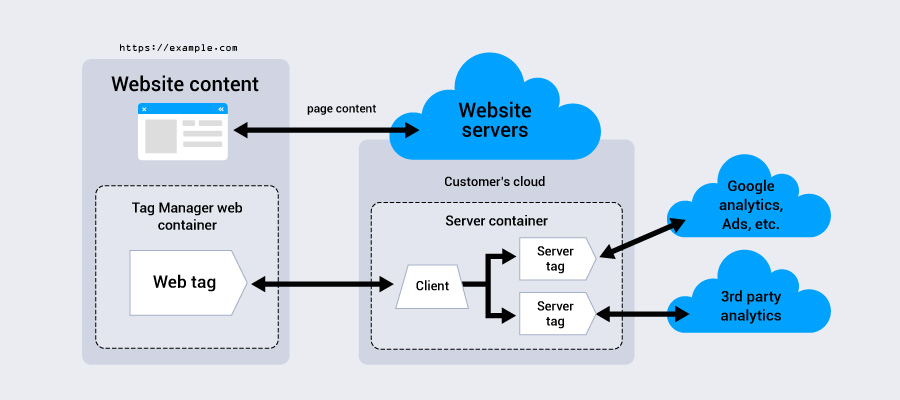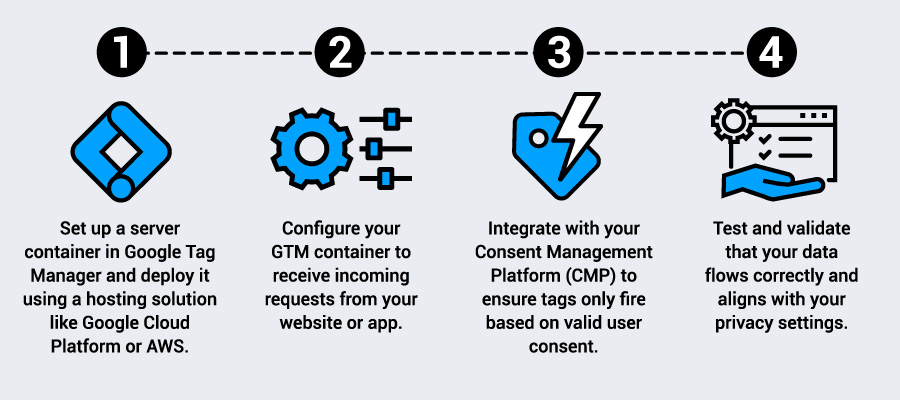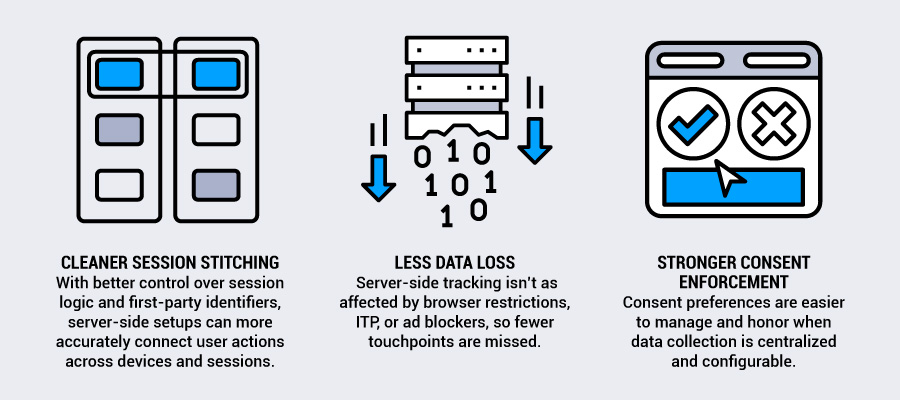Cross-device tracking explained: What marketers need to know
Your customers don’t live in a single-device world. They browse on mobile during lunch, research on a desktop at work, and purchase on a tablet from the couch at home.
Yet most marketing analytics treat each device as a separate user, creating fragmented data that misses the full customer story.

Cross-device tracking connects these dots, revealing how people actually move among devices throughout their journey. But here’s the challenge: traditional tracking methods often rely on invasive techniques that compromise user privacy.
The solution? Privacy-first approaches that respect consent while delivering the insights you need.
What is cross-device tracking and why does it matter?
Cross-device tracking identifies when the same person uses multiple devices to interact with your brand. Instead of seeing three separate users, you recognize one customer who visited your site on mobile, compared prices on their desktop, and then completed their purchase on a tablet.
This unified view transforms how you understand customer behavior. Without it, you’re flying blind through multi-device journeys that define how people actually browse, shop, buy, and otherwise engage with brands.

The benefits of cross-device tracking
Connected customer journeys reveal opportunities that single-device data misses:
- Accurate attribution: See which touchpoints actually drive conversions, not just the last device used.
- Reduced ad waste: Stop showing the same ad to someone who has already converted on another device. Cross-device insights from device attribution can lower the cost per action by 30–50 percent and boost ROI by 50–100 percent.
- Better personalization: Deliver consistent experiences across devices based on complete user preferences, not fragmented device-specific data.
- Improved measurement: Calculate true return on ad spend (ROAS) by connecting all touchpoints in the customer journey, regardless of device.
These benefits matter more than ever as customers expect seamless experiences across every touchpoint. But achieving them requires marketers to understand cross-device attribution.
Read more about key marketing KPIs to track for privacy-conscious marketers.
How does cross-device tracking work?
Cross-device tracking connects user interactions by finding common identifiers across devices. This could be login credentials, email addresses, or behavioral patterns that suggest the same person is using different devices.
The process involves three steps:

The key is finding reliable signals that link devices while respecting user privacy and consent preferences. This balance becomes more challenging as privacy regulations, such as the EU’s General Data Protection Regulation (GDPR), reshape the cross-device ad targeting landscape.
Types of cross-device tracking methods
Different cross-device tracking methods offer varying levels of accuracy and compliance with privacy regulations. Understanding these options helps you choose approaches that balance insight quality with user trust.
Cookie-based tracking
Traditional cookie-based tracking uses third-party cookies to follow users across websites and devices. While effective for cross-site analytics, this method faces major limitations as browsers phase out third-party cookies.
Safari and Firefox already block third-party cookies by default. Google is giving users the option to block them, too. This shift makes cookie-based cross-device tracking increasingly unreliable.
Do you know the difference between zero, first, second, and third-party data? Discover key differences and how to leverage them.
Mobile device IDs (IDFA, GAID)
Apple’s Identifier for Advertisers (IDFA) and Google’s Advertising ID (GAID) provide device-level tracking for mobile apps. These identifiers enable cross-app tracking and help connect mobile app behavior with web activity.
However, Apple has required explicit user consent for IDFA access since iOS 14.5. Google plans similar restrictions for GAID. This means fewer users are trackable through device IDs, reducing the effectiveness of this method.
Universal IDs and identity graphs
Universal ID solutions like Unified ID 2.0 use encrypted email addresses to create privacy-conscious identifiers. Identity graphs combine multiple data points to build probabilistic models of cross-device usage.
These methods show promise but require significant infrastructure and user consent to function effectively. They work best when integrated with first-party data collection strategies.
How marketers use cross-device targeting and attribution
Cross-device insights help marketers deliver more relevant, effective campaigns by connecting customer interactions across phones, tablets, and computers. Privacy-conscious teams are leveraging these capabilities to improve performance and better understand customer behavior.
Retargeting across devices
Reach users who browse on one device and convert on another. For example, show desktop ads to people who viewed products on mobile.
Sequential messaging
Cross-device analytics enable you to guide customers through the funnel with ads tailored to each stage of their journey. For instance, start with awareness on mobile, then follow up with product-focused messaging on desktop.
Cross-device personalization
Cross-device personalization carries user preferences over from one device to another. For example, if someone adds an item to their mobile cart, you can highlight that same product when they return to the desktop.
Attribution modeling
Track the full customer journey across devices to see which touchpoints drive results. This helps reveal the true value of each channel, not just the one that gets the final click.
When marketers can link these cross-device conversions, key metrics like ROAS become more meaningful. But as privacy rules tighten, applying these strategies requires smarter tools and thoughtful implementation.
Are you ready for the future of data in marketing? Learn more about how you can adapt while remaining privacy-compliant.
The cross-device challenge in a privacy-first world
Privacy regulations, browser changes, and consumer expectations are reshaping cross-device tracking. The challenges run deeper than many marketers realize, creating measurement gaps that affect every aspect of campaign optimization.
Third-party cookie elimination
Browsers like Safari and Firefox already block third-party cookies by default, and Chrome enables blocking as an opt-in setting for users. Since third-party cookies have historically been a primary way to link behavior across devices and platforms, their disappearance creates major attribution gaps and limits remarketing capabilities.
Device ID restrictions
Apple’s App Tracking Transparency (ATT) framework, introduced with iOS 14.5 in 2021, requires users to explicitly opt in to share their device ID (IDFA). Opt-in rates hover around 25 percent, making reliable mobile tracking far less feasible. Google is also going to offer users the option to opt in or out. This will extend these limitations across more devices.
Identity resolution gaps
Without consistent identifiers to connect a person’s behavior across devices, marketers face growing blind spots. Even authenticated experiences don’t always carry over cleanly between apps, browsers, or platforms, especially when users don’t log in. This weakens both customer journey mapping and the ability to attribute results accurately.
GA4 cross-device tracking limitations
Google Analytics 4 aims to address cross-device fragmentation through a combination of first-party data, machine learning, and probabilistic modeling. However, in the absence of reliable identifiers, GA4 often relies on inferred data. While better than nothing, this approach can compromise accuracy for both attribution and audience insights.
Compliance complexity
Laws like the GDPR and other privacy laws around the world require explicit user consent for tracking across each device and platform.
Managing this consent framework is technically and operationally complex, especially when users provide different permissions on different devices. The result is further data loss and limited visibility into user behavior.
These challenges compound each other. Losing third-party cookies reduces identity resolution capabilities. Lower device ID availability makes probabilistic modeling less accurate. And stricter consent requirements limit data inputs for machine learning models.
The result? Fragmented customer journeys that undermine campaign optimization and budget allocation decisions. This is where server-side tracking offers a path forward.
How server-side tracking strengthens cross-device analytics
Server-side tracking offers a more privacy-compliant solution to cross-device measurement challenges. By processing data on secure owned servers rather than in browsers, this approach reduces dependence on third-party cookies and provides more reliable data collection.
Server-side infrastructure centralizes data from multiple sources. This includes web interactions, mobile apps, and offline touchpoints. This unified data environment makes it easier to connect user interactions across devices using first-party identifiers.
When users provide consent, server-side tracking can link their interactions across browsers and apps more effectively than client-side methods. The approach also bypasses ad blockers and browser restrictions that limit traditional tracking.
Most importantly, server-side tracking gives you control over data quality and privacy compliance. You decide which data to collect, how to store it, and when to share it with third-party platforms. This foundation enables more sophisticated cross-device attribution approaches.

Learn more about server-side tagging and tracking.
Cross-device attribution with GA4 and server-side Infrastructure
Google Analytics 4 includes built-in capabilities for modeling user behavior across devices, but these models are only as good as the data behind them. With rising privacy constraints and fragmented identifiers, GA4 increasingly relies on machine learning to fill the gaps. Server-side tracking helps strengthen these models by delivering more complete, accurate, and consented data.

GA4’s approach to cross-device modeling
GA4 estimates cross-device journeys using available signals such as signed-in user data (e.g. Google accounts), device characteristics, IP addresses, and behavioral patterns. When a user visits a website on mobile and then converts on desktop, GA4 uses probabilistic modeling to determine whether those sessions likely belong to the same person.
However, if key data points are missing or blocked due to cookie restrictions, ad blockers, or consent opt-outs, GA4’s ability to make these connections weakens. Attribution becomes more fragmented, and marketers lose visibility into what’s driving conversions.
How server-side tagging improves attribution accuracy
Server-side tracking addresses these limitations by collecting data in a more stable and consistent environment. Instead of relying on browser-side scripts, data is captured and processed through a server you control. This improves reliability in several ways:

As a result, the data GA4 receives is more complete, which directly improves its ability to model cross-device behavior and attribute results accurately.
Strengthening GA4 through integrations
One practical way to boost cross-device tracking is by integrating GA4 with other marketing platforms through a shared server-side infrastructure.
When GA4 and platforms like Facebook receive high-quality, synchronized data, they can better align conversions across devices and channels. This not only improves attribution accuracy but also helps to ensure your campaign performance data reflects the full customer journey, not just the final click.
By combining GA4 with server-side tracking and integrations, marketers can reduce data gaps, respect user privacy, and make smarter optimization decisions. These choices are based on trusted, end-to-end insights.
Respecting privacy while tracking across screens
Improving cross-device attribution and data quality isn’t just a technical challenge; it also depends on maintaining user trust and complying with privacy regulations. Transparent, privacy-compliant tracking is essential for gathering consented data that powers reliable insights.
Server-side tracking plays a key role here by centralizing data management, giving marketers better control over how data is collected, stored, and shared. This centralized approach makes it easier to honor user consent preferences and data deletion requests consistently across all devices and platforms.
Clear communication about data use builds trust with users. When people understand the benefits, like more personalized experiences and relevant ads, they’re more likely to provide accurate information and stay engaged with your brand.
Security is another critical factor. Processing data on secure servers instead of in browsers reduces the risk of data breaches and better protects sensitive user information.
Ultimately, adopting a privacy-first approach is about more than compliance. It’s about creating lasting, respectful customer relationships that support sustainable growth and effective marketing over time.
Building sustainable cross-device strategies
Cross-device tracking isn’t going away, but the methods are evolving toward privacy-first approaches. Success requires balancing measurement needs with user trust through transparent consent practices and secure data handling.
Going forward, marketers must be able to connect customer journeys across devices while respecting privacy preferences. This means investing in server-side infrastructure, first-party data strategies, and consent management tools that support both compliance and performance.
By doing so, you can maintain cross-device insights while building the trust that drives long-term customer relationships. The result is better measurement, more effective personalization, and sustainable growth in a privacy-conscious world.
